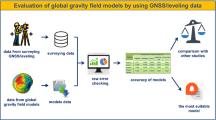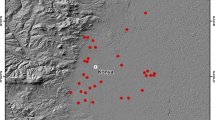Abstract
In this study, 96 bench marks and unified control points across South Korea were selected as GPS/Leveling stations, GPS surveying was conducted in the Network-RTK (VRS) method and the results were utilized to calculate geometric geoidal heights. These geometric geoidal heights were utilized in the evaluation of the geoid models comprising global gravity field models, such as EGM2008 and EIGEN-6C4, and South Korean geoid models, such as KNGoeid13 and KNGeoid14. In addition, geoid model KNGeoid14, which was found to have the highest accuracy and precision through the evaluation, was utilized to calculate GPS derived orthometric heights, and the results were evaluated to review the possibility of orthometric height surveys using the GPS/Geoid method. As for the results of the study, in the evaluation of the global gravity field models, the standard deviations of EGM2008 and EIGEN-6C4 were shown to be almost the same as the values were 7.0 cm and 7.1 cm respectively, and geoid model KNGeoid14 was found to have been improved compared to KNGeoid13 as its RMS and standard deviation were shown to be smaller than those of KNGeoid13. In addition, differences in the orthometric height values of 96 points derived in the GPS/Geoid method were analysed using geoid model KNGeoid14, and, in the results, the average error was shown to be 3.9 cm and the standard deviations was shown to be 5.2 cm so that the possibility of utilization of the GPS/Geoid method in orthometric height surveys with the decimeter accuracy could be identified.
Similar content being viewed by others
References
Back, K., Lee, J., Shin, G., Kwon, J. H., and Moon, J. (2014). “Construction and precision verification of Korean national geoid model KNGeoid13.” Proc., of the 2013 Spring Conference of the Korean Society of Surveying, Geodesy, Photogrammetry, and Cartography, The Korean Society of Surveying, Geodesy, Photogrammetry, and Cartography, Seoul, pp. 111–114.
Förste, C. H., Bruinsma, S. L., Abrikosov, O., Lemoine, J.-M., Schaller, T., Götze, H.-J., Ebbing J., Marty, J. C., Flechtner, F., Balmino, G., and Biancale, R. (2014). “The latest combined global gravity field model including GOCE data up to degree and order 2190 of GFZ Potsdam and GRGS Toulouse.” 5th GOCE User Workshop, Paris, France.
Hong, C. K., Kwon, J. H., Lee, B. M., Lee, J., Choi, Y. S., and Lee, S. B. (2009). “Effects of gravity data quality and spacing on the accuracy of the geoid in South Korea.” Earth Planets Space, Vol. 61, pp. 927–932.
Kearsley, A. H. W. (1988). “The determination of geoid-ellipsoid separation for GPS levelling.” The Australian Surveyor, Vol. 34, No. 1, pp. 11–18. DOI: 10.1080/00050326.1988.10438999.
Lee, J. and Kwon, J. H. (2015). “Construction and precision verification of Korean national geoid model KNGeoid14.” Proc., of the 2015 Conference of the Korean Society of Surveying, Geodesy, Photogrammetry, and Cartography, The Korean Society of Surveying, Geodesy, Photogrammetry, and Cartography, Gyeongnam, pp. 177–179.
Lee, S. B. (2000). “A study on the geoid modeling by gravimetric methods and methods of satellite geodesy.” J. Korean Society of Surveying, Geodesy, Photogrammetry, Cartography, Vol. 18, No. 4, pp. 359–367.
Lee, S. B. and Kim, C. Y. (2012). “Development of regional gravimetric geoid model and comparison with EGM2008 gravity-field model over Korea.” Scientific Research and Essays, Vol. 7, No. 3, pp. 387–397, DOI: 10.5897/SRE11.1681.
Lee, S. B. and Lee, D. H. (2010). “Evaluation of the topographic effect using the various gravity reduction methods for precise geoid model in Korea.” Gravity, Geoid and Earth Observation, International Association of Geodesy Symposia, Vol. 135, pp. 273–281, DOI: 10.1007/978-3-642-10634-7_35.
Lee, S. B., Kim, J. S., Kim, C. Y., and Kwon, J. H. (2009). “Calculation of geometric geoidal height by GPS surveying on 1st and 2nd order Benchmark Line.” J. Korean Society of Surveying, Geodesy, Photogrammetry, Cartography, Vol. 27, No. 2, pp. 213–223.
Lee, S. B., Yun, H. S., and Choi, J. H. (1996). “Gravimetric geoid determination by Fast Fourier Transform in and around Korean peninsula.” J. Korean Society of Surveying, Geodesy, Photogrammetry, Cartography, Vol. 14, No. 1, pp. 49–58.
NGII (2013). Korean national geoid model development and study on the vertical reference link in Asia-Pacific area, National Geographic Information Institute, Report No. 11-1613436-000039-01.
NGII (2015). Research for building a next generation national control points network. National Geographic Information Institute, Report No. 11-1613436-000054-01.
Pavlis, N. K., Holmes, S. A., Kenyon, S. C., and Factor, J. K. (2008). “An earth gravitational model to degree 2160: EGM2008.” Proc., of the EGU General Assembly 2008, Vienna.
Author information
Authors and Affiliations
Corresponding author
Rights and permissions
About this article
Cite this article
Lee, S.B., Auh, S.C. & Seo, D.Y. Evaluation of global and regional geoid models in South Korea by using terrestrial and GNSS data. KSCE J Civ Eng 21, 1905–1911 (2017). https://doi.org/10.1007/s12205-016-1096-y
Received:
Accepted:
Published:
Issue Date:
DOI: https://doi.org/10.1007/s12205-016-1096-y




